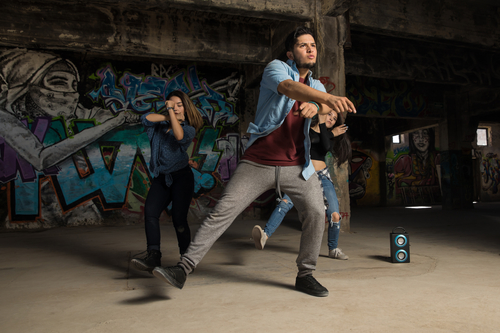 Filming and photographing in public venues – parks, streets, subway stations – for ads, TV spots and social media videos can produce exciting, creative results for advertising campaigns, but companies advertising should be careful when using shots featuring graffiti in the background. It may be protected by copyright law. Even if the graffiti has not been lawfully created, but rather produced in an act of vandalism or trespass, the artist could raise a copyright infringement claim that could lead to a lawsuit.
Filming and photographing in public venues – parks, streets, subway stations – for ads, TV spots and social media videos can produce exciting, creative results for advertising campaigns, but companies advertising should be careful when using shots featuring graffiti in the background. It may be protected by copyright law. Even if the graffiti has not been lawfully created, but rather produced in an act of vandalism or trespass, the artist could raise a copyright infringement claim that could lead to a lawsuit.
In the past, street artists shunned mainstream publicity, so the last thing they wanted to do was openly claim ownership of copyrights in their works or take corporate money for commercial use. But cultural attitudes about graffiti and street art have changed. The once completely underground art scene is now beginning to operate more openly, making the likelihood of legal claims and litigation higher.
Several high-profile companies, American Apparel, Coach, American Eagle Outfitters and H&M who shot advertisements in public spaces, have found themselves inadvertently in the midst of such legal disputes with street artists. Even though an advertiser may have had permission from the property owners, even though the “artwork” was unsanctioned and unsigned or “tagged,” the graffiti artists have come forward after the ads were already in circulation, identified themselves and sought compensation and damages.
This is not only a problem for advertising and videographers, but for any property owner with graffiti anywhere on their property. Can they demolish that work? Can they paint over it? Can they have photographs taken of their property? Will they be sued down the road by someone claiming to be a copyright owner of a legitimate work of protected art?
As for how this kind of litigation is resolved in court, there is no case law precedent on all of these issues. These cases tend to be settled out of court, because regardless of the merit of an infringement claim, they are costly to defend and the unwarranted negative publicity can injure a company’s reputation.
Also, from a legal standpoint, the question of whether the copyrights of illegally created street art are valid has not yet been determined – so there would be some element of doubt as to how a litigation would be decided.
So how do property owners and companies prevent themselves from falling victim to this type of litigation? And how do they best mount a defense if a copyright infringement claim is made?
The first step is to secure consent from the graffiti artist, and finding that artist may entail:
- Contacting the property owner (if applicable) to obtain the name of the graffiti artist
- Contacting business owners or residents in the neighborhood
- Contacting local graffiti artists groups or associations though social media
- Asking known graffiti artists if they know the identity of the artist in question
- Canvassing the neighborhood for other works created by the artist
- Reaching out to the local police department
If a property owner or a company is unable to get permission from the graffiti artist to use the artwork in promotional photos or videos, there are one of two things that should be done. One, they should only use a small portion of the artwork so that it is not prominently displayed in the ad campaign. That way, if the artist decides to pursue a claim of copyright infringement, the property owner or company can support a “fair use” defense. A second appropriate course of action is to select alternative graffiti art – specifically works they have permission to use.
It’s imperative that the artwork is not altered or destroyed in any way. Doing so will weaken a defendant’s case in the event of a copyright infringement lawsuit and subject an advertiser to additional claims under the Visual Artists Rights Act.
No matter if the street art is illegal, copyright infringement claims can create sticky legal situations for property owners and companies alike. It is always better to err on the side of caution.
Image Source: Deposit Photos

![[IPWatchdog Logo]](https://ipwatchdog.com/wp-content/themes/IPWatchdog%20-%202023/assets/images/temp/logo-small@2x.png)


![[Advertisement]](https://ipwatchdog.com/wp-content/uploads/2024/04/Patent-Litigation-Masters-2024-sidebar-early-bird-ends-Apr-21-last-chance-700x500-1.jpg)

![[Advertisement]](https://ipwatchdog.com/wp-content/uploads/2021/12/WEBINAR-336-x-280-px.png)
![[Advertisement]](https://ipwatchdog.com/wp-content/uploads/2021/12/2021-Patent-Practice-on-Demand-recorded-Feb-2021-336-x-280.jpg)
![[Advertisement]](https://ipwatchdog.com/wp-content/uploads/2021/12/Ad-4-The-Invent-Patent-System™.png)







Join the Discussion
4 comments so far.
Anon
September 9, 2018 11:51 amEric,
My views are not bound to an emotional state as you suggest and instead are firmly established in a deeper and more pervasive legal view.
In short, my view stems from the legal sanctity of personal property and the fact that even a proper branch of the government (proper so far as pertains to which branch writes statutory law) may NOT write that law in a vacuum and ignore other protections (notably of personal property).
A fundamental legal (not emotional) context is that one is NOT free to express themselves in disregard of existing laws.
Strictness as to expression does not run afoul of the law (or other laws of protection) as may be the case for any law sanctioning expression at the expense of another’s personal property.
Do not mistake the force of my legal position for a postion of emotion.
Eric Berend
September 8, 2018 03:35 pm@ 1., ‘Benny’, and 2. ‘Anon’:
You each are reacting to this news according to an emotional impulse, forgetting your legal experience: statutory law trumps equitable jurisprudence, excepting that which would empower such excesses as a violation of the doctrine of unconscionability.
The U.S. 101st Congress of 1990, does not agree with either of you. Apparently, the public interest benefit of supporting and protecting visual artists’ perogatives in producing their publicly-situated art, is considered to exceed that of the individual property owner’s putative harm suffered thereby.
Now, I would be interested to know how either or both of you view the notion of legislative intent as applied in a situation such as this, with competing tension of the disparate interests involved. We’re discussing implications of one type of intellectual property, interceding over a manifest property interest expressed in conventional real property law. Any thoughts in this regard, good counselors?
BTW, ‘Benny’, given that “ad campaigns” tend to be creatures of public (albeit commercialized) opinion, do you not ignore here, the potential goodwill gain and possible mass appeal of engaging the local so-called “criminal” artist, as an opportunity to demonstrate ‘good corporate citizenship’ in an era of increasing consumer cynicism?
After all, HP is spending millions of dollars right now to engender general public goodwill in a prominent ad campaign with the motto “Keep Inventing”.
With these corp-o-slug infringer-sycophants such as ‘Benny’, here, the irony – and hypocrisy – is rich. Very rich. Ripe for the rhetorical knife.
Anon
September 6, 2018 10:17 amAn interesting legal problem, albeit one with a ready (and very familiar) tort/equity answer:
Do not come to the table with unclean hands.
To wit, I would apply this simple concept as follow:
You broke the law to create your expression?
Fine, you lost rights to that expression.
Benny
September 6, 2018 05:11 amThe simplest work-around (quite common where I live) is to shoot your ad campaigns outside your home country. Easier than asking criminals to step forward and identify themselves, so that they can receive $$ in royalties and pay $$$$ in property damage and trespass lawsuits.